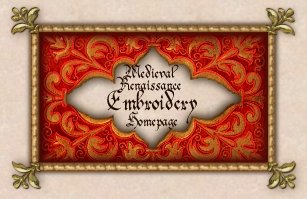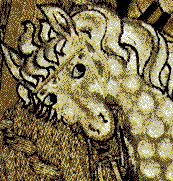

From: cole joan
> Ricahrd Larmer, Esq.
From: TByrnes883@aol.com
Greetings....
Date: Wed, 12 Jul 1995 12:40:32 -0400 (EDT)
Many, many, moons ago, when I had an Anglo-Saxon persona, I did some research into embroidery. I found some treatises in the Univresity Library here at McMaster. I might even be able to dig up the article I wrote about it; I will see what I can find and let you (all) know.
From: "Traylor"
Hidegarde provides an excellent list of sources to which I would add:
From: Susan Carroll-Clark
Greetings!
To: sca-middle@dnaco.net
Date: Tue, 11 Jul 1995 19:00:49 -0500 (CDT)
> P.S. I am interested in any info on Opus Anglicanum (sp?) especially
> secular. My lady does this and I want examples for putting onto my cote
> hardies.
> From: Andrew Lowry
Opus Anglicanum (English Work) - flowered during 13th/14th centuries
Reference works
Survey of various styles
Kay Staniland: Medieval Craftsmen: Embroiderers ISBN 0-8020-6915-0
(This gets into the social context as well as having many lovely photos)
Pamela Warner: Embroidery: A History ISBN 0-7134-6106-3
(Has nice pictures showing the spiral pattern that was used in the split stitch, as well as pictures showing how underside couching was accomplished - This book has a color plate of a lute-playing angel on horseback that I really like... though it isn't secular)
Mary Rhodes: Batsford Book of Canvas Work ISBN 0-7134-2669-1
(Introductory material also shows how the spiral pattern and underside couching were done before getting into the main topic of the book - counted thread embroidery through history)
Focussed on Opus Anglicanum
A.G.H. Christie: English Medieval Embroidery. Oxford: Clarendon Press, 1938
"The definitive work on opus anglicanum...try a university library and expect to have to use it IN the library..."
Donald King: Opus Anglicanum: English Medieval Embroidery.
London: The Curwen Press, 1963.
"Exhibition catalog..."
My own interest is in counted thread work, but I admire your wife for being able to do this technique - given that one of the copes made during the era might take a workshop 3 1/2 years to produce... presumably "full-time". I look at the stuff in the pictures and I can only say "Wow!"
I'm certainly no expert on this topic, mostly just having read the surveys, but I do expect you to have a challenge finding examples of secular pieces...it seems that this style was basically produced by professionals for the church. If you do hear of better sources than those I know, I'd appreciate hearing of them. I am trying to compile a web page on medieval/rennaissance embroidery, and this topic is one that I don't have coverage of yet.
Hildegarde, Barony of Wurm Wald
http://ux1.cso.uiuc.edu/~jcole
Date: Wed, 12 Jul 1995 12:28:03 -0400
To: sca-middle@dnaco.net
Opus Anglicanum....."work of the English".......enjoyed its heyday during 1250-1350. You may be able to find more information if you concentrate on these years. Yes, you are correct, it was indeed used in the secular also.
Metal thread designs and geometric designs were very prominent. Early brick patterns and later lozenge and chevron patterns were done. Geometric frameworks were very often found with the open spaces between focal point and the frameworks with angels, heraldic shields, beast/man masks, compass stars and foliage.
Here are a few resources that you may find helpful in designing your next projects:
Antrosbus, Mary et al., Needlework through the Ages. London: Hodder and Strought, Ltd.,1928. (try a University library)
Geijer, Agnes. The History of Textile Art. Phillip Wilson Publishers, Ltd., 1979.
Jones, Mary Eirwen. A History of Western Embroidery. London: Studio Visto, 1969.
Snook, Barbara. English Embroidery. London: Bell and Hyman, 1974.
Williamson, Paul. The Medieval Treasury. London: Victoria and Albert Museum. 1986.
You may also wish to write the V & A Museum in London. I have found them to be very Helpful and prompt in their responses. They have a very broad collection of items and are very willing to accomodate your inquires.
Hope this helps in your quest......
Lady Siban
From: TByrnes883@aol.com
From: Bruce Mills
To: sca-middle@dnaco.net
Abayo,
Akimoya(-dono)
From: Bruce Mills
To: sca-middle@dnaco.net
Date: Thu, 13 Jul 95 00:49:06 -0500
Schuette, Marie & Muller-Christensen, Sigrid. _A Pictorial History of Embroidery_, New York: Frederick A. Praeger, Publisher, 1964
This book includes a fairly detailed description of the method of construction of the style and plates of some of the copes Hildegarde mentioned.
King, Donald & Levey, Santina. _The Victoria and Albert Museum's Textile Collection: Embroidery in Britain from 1200 to 1750_. New York: Canopy Books, 1993.
This contains some of the best color plates I've seen so far.
I disagree with Hildegarde as to why we have no examples of secular work. I do not for a moment think that they did not exist. My guess is that:
1) The church pieces were more carefully kept and less often used, so they survived longer. Churches tend to be very careful of such pieces. A friend in the clergy related a story to me of how he saw a several hundred year old piece of embroidered vestment used for Easter services, I think in England. The wearer was outfitted with a structure of wire and netting about his ankles to catch stray threads or bits of gold that might fall off, so that repairs could be made later. True, this is a modern example, but such care is why these vestments have lasted through the centuries.
2) Conversely, secular pieces were worn, and therefore, wore out. Not only that, but at least in later period, we know it was customary to remove embroidered decoration from one piece of clothing to move it to another. So pieces continued to be worn again and again.
3) The reason we have relative few fully intact period textile/embroidery pieces available is that period dyes were somewhat caustic and contributed to the breakdown of the textile material (a friend garnered this fact from museum staff on a recent trip to England).
Of course, there's no way to prove the argument one way or another, but while I realize the great embroidery workshops existed to produce the great works, I doubt all embroidery was confined to them. Else, why all the domestic paintings of ladies embroidering? I also doubt that the young women embroidering in their homes were producing strictly ecclesiastical pieces. I certainly wouldn't be ;-)
Of course, I'm no expert on this either. Anyone else?
Ciara
Gach uile rud nua faoi sholas an lae
From: "Traylor"
To: sca-middle@dnaco.net
Date: Thu, 13 Jul 1995 11:04:44 -0400 (EDT)
While it is true that most of our _surviving_ examples of *opus anglicanum* are large, elaborate ecclesiastical garments, it does not necessarily translate that the style was unknown for secular items, though probably not on the same scale. I have at hand an article from _Textile History_20 (2) 225-34 (1989) on two embroidered seal bags from Westminster Abbey. One of these bags is an appliqued and embroidered example. I also have an introductory article on Embroidery and Textiles by Donald King from a big exhibition catlogue on the Gothic period which mentions known lists of silk and embroidery suppliers to Henry III, as well as several prominent 14th century embroiderers whose names are known. King also mentions secular uses for embroidery, including royal vestments, cushions, and bed hangings. Since the 13th and 14th centuries were those in which the _opus anglicanum_ was at its height, it is reasonable to postulate that this style, (though perhaps not in the exquisite perfection of the papal copes) was being used for secular purposes. (Remember also the tiny number of surving whole pieces from this period. The ecclesiastical examples survived because they were carefully preserved).
Cheers!
Nicolaa/Susan
From: Susan Carroll-Clark 
![]()
![]()
![]()
![]()
![]()
![]()
![]()
![]()
![]()


Copyright © 1995-1999 Joan Schraith Cole.
Created: Saturday, July 29, 1995, 5:50:35 PM
Updated March 28, 1999
http://www.advancenet.net/~jscole/angelic.html
